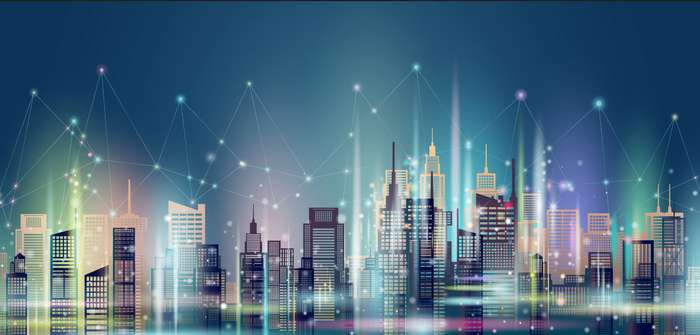Smart cities are also a topic at this year’s Light + Building in Frankfurt. Concepts for the intelligent and networked city of the future are already available. The efficient and safe networking of places, people and infrastructures is the focus here.
There is still a long way to go before we achieve the energy transition of 2030. The central building blocks here are reducing consumption in buildings, promoting sustainable energy generation and expanding electromobility. The issue is taking on a whole new explosive nature as a result of rapidly rising prices for oil and gas and the need to secure the supply of raw materials.
Table of Contents: What awaits you in this article
Smart cities: Digitization of infrastructure as the basis
One trend in recent years has been urbanization. Due to limited space, optimal utilization is essential. Sustainable additions to real estate in timber construction can create expanded living space. However, digitalization and electrification of the infrastructure must be seen as the basis for smart cities and their secure and efficient energy supply. With this step, it is then possible to use sustainable energy sources such as wind and solar economically (smart grids). The coupling of sectors is also possible.
Innovation as a key factor
Innovations as well as technological developments enable new approaches to solutions that are highly relevant for society and politics. They thus play a key role in the concepts of smart cities. For example, the invention of the lithium-ion battery was crucial to the development of sustainable electromobility. And for the economic use of sun and wind as regenerative energies, top technical performance in generation, transmission and distribution is essential.
The further development of information and communications technology is of central importance in this context to ensure efficient networking. In a “finished” smart city, places, infrastructures and people will then be networked with one another.
Smart buildings: the basis of smart cities
No smart cities without smart buildings – they are the basis. People spend the majority of their time there. Comprehensive networking ensures that the data from the numerous sensors is available to all trades. Among other things, this results in lower energy consumption.
According to the German Electrical and Electronic Manufacturers’ Association, savings of 30 to 40 % in energy requirements and CO₂ emissions are possible on the basis of intelligent building automation.
Self-learning systems enable the intensive involvement of building users. Examples include the display of individual escape routes on mobile devices or the needs-based control of heating, lighting and air conditioning. Security systems can also be implemented that not only detect but also predict dangers, such as a burglary or fire.
Forward-looking concepts as a solution to future challenges
Innovative ideas and forward-looking concepts are needed to meet the challenges of the future (climate change, urbanization, etc.). Smart cities are no longer a vision, but are already being implemented. As early as 2014, the EU 240 designated European cities that are pursuing smart city concepts.
An intensive exchange between all those involved – both nationally and internationally – is the basis for achieving efficient solutions beyond the pilot project. If this is the case, smart cities can already become reality in the near future and gain acceptance among residents.
Light + Building as a platform for exchange
The fall edition of Light + Building 2022 in Frankfurt a.M. provides a suitable platform for this important exchange. In addition to smart cities, the focus will also be on concepts for networked security, building automation, advanced e-charging infrastructure, and intelligent neighborhood and energy management. The trade fair will take place from 02 to 06 October 2022 at the Messe Frankfurt exhibition center.














